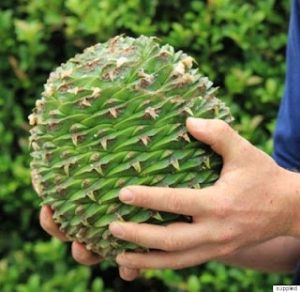Our world is full of wonderful trees around us, In which many such trees are poisonous and you should know about them before eating and touching them. Look around in your area and see if you can find these trees. If so, then you have to keep your distance from them.
Manchineel Plant:
It is a species of flowering plant. The Spanish name “manzanilla” means “little apple“. It is also called Beach Apple. Spanish name is manzanilla de la muerte, “little apple of death”. It is the most poisonous tree in the world, and its milky-white sap contains several toxins called phorbol, which causes blisters and burns on the skin.
This tree is found in the coastal areas of Florida and some areas in the north and today it comes under the endangered species.
The Strychnine Tree:

It is a medium-sized plant that can reach up to 12m. It is a major source of the highly toxic, bitter alkaloids strychnine and brucine found in the seeds. Its seeds are used to poison arrows and kill wild mammals. It is found in India and Southeast Asia.
‘The Suicide Tree’ Cerbera odollam:

This tree grows in coastal salt marshy areas. This tree is called the “suicide tree“.
The toxin present in its fruit is called cerberine, which causes irregular heartbeat, burning sensation in the mouth, vomiting, headache, irregular respiration, coma, and eventually death.
According to reports, more than 500 deaths occurred in Kerala alone due to ingestion of this plant.
Despite the tree being poisonous, scientists also use its seeds to manufacture biopesticides, deodorants, and a potential feedstock for the production of biodiesel.
Bunya Pine:

This tree is mainly found in Queensland, Australia. It is also called the “monkey puzzle tree“. Its cones are of perfect size and after pollination, it takes 15 months to mature and the fruit weighs about 10 kg. After completing the time of maturity, they start falling, due to which any person standing under the tree can fall and get seriously injured.
Milky Mangrove:

This tree is called Blind Tree, Poisonfish Tree, and Buta Buta Tree. Its toxic properties cause blisters and when its latex comes in contact with the eyes, it can make you blind.
These are shrubs and trees that reach up to 15 m. It grows in brackish water in mangrove rain forests, with a distribution limited to India in the west, Bangladesh in the north, and Australia in the south.
Oleander:

Its shrubs and trees are up to 2-6 meters high. This plant is used as an ornamental. Consuming large amounts can cause vomiting, skin irritation, dizziness, nausea, and irregular heartbeat. Despite its toxic properties, the seeds of its leaves are used to make medicine. It is a landscape plant there is no specific area has been identified for this plant.
The Sandbox Tree:

This tree is also known as possumwood, monkey no-climb, and Jabilo. There are thorns(spines) all over its stem. Its spine-like structure secretes a poisonous sap that causes skin irritations.
Its seeds explode when they mature and reach 45 meters from the tree. This tree is found in more humid environments in North and South America, including the Amazon rainforest.
Yew:

This plant contains very dangerous poison in every part of the plant except the aril (which covers the seed). Ingestion of any part of the plant results in death. No plant can be grown under the surrounding of these trees.
It is an evergreen plant or tree found in Western Europe, central Europe, and southern Europe (including Great Britain and Ireland), northwest Africa, northern Iran, and Southwest Asia. Its parts are used in medicine (cancer treatment), wood making, etc.
Angel’s Trumpet Flower:

This bell-shaped flowering plant looks very beautiful, but every part of it contains poisonous tropane alkaloids. People and animals are poisoned by touching, smelling, and eating any part of the plant that causes you to hallucinate or act like a zombie state.
Gympie-Gympie:

This plant is known by various names like stinging tree, and stinging bush. It has heart-shaped leaves when it comes in contact with the victim it causes burning and stinging but in some cases, it may swelling, and pain in the contact area. It is found in the rainforests of Australia and Malaysia.
